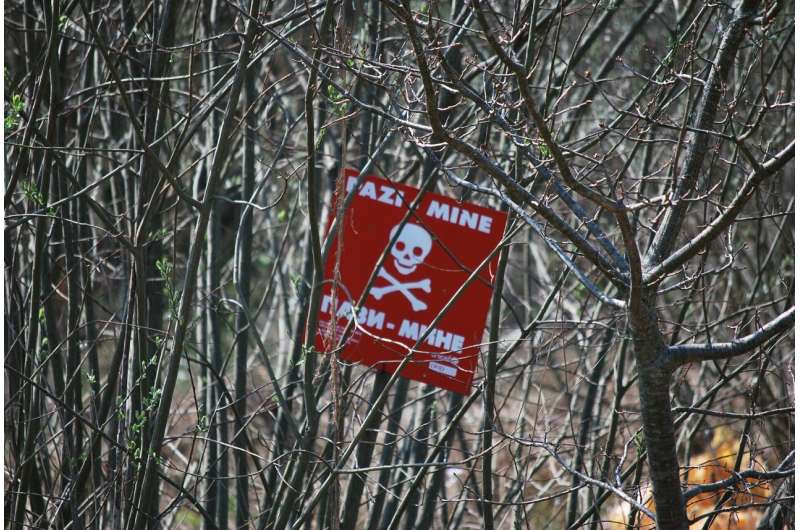Deaths from landmines are on the rise, and clearing them all will take decades

Nearly quarter-century after most of the world signed a convention outlawing the use of antipersonnel landmines, the number of people being killed or maimed by these insidious and lethal weapons remains high—and rising. The Landmine Monitor for 2021, released on November 10, reported 7,073 casualties in 2020, including 2,492 people killed and 4,561 wounded.
This is a significant increase on the 5,554 people killed and wounded in 2019. Syria was the worst affected country, reporting 2,729 casualties. The report says that the use of improvised explosive devices (IEDs) by insurgents, many of which were deliberately aimed against the civilian population. Other countries with more than 100 recorded casualties in 2020 were Afghanistan, Burkina Faso, Colombia, Iraq, Mali, Nigeria, Ukraine, and Yemen,
One of the worst things about this is that many of these people will have died or been maimed by a mine that was laid years, perhaps even decades, previously, but which have not yet been detected and neutralized.
Our research at the University of Sheffield has, for the past decade, been looking at quantifying how the soil around landmines changes how deadly they are. According to the Landmine Monitor report, about 5,000 square kilometers are known to need clearing of mines. By my calculation, at the current rate of clearance this will take about 34 years and cost around £14 billion.
Indiscriminate war crimes
Historically, military forces deployed anti-personnel mines (those designed to explode in the presence, proximity or contact of a person) to create defensive barriers or to deny access to specific regions or facilities. Military use requires regions to be marked as minefields—not marking out mine-infested regions is regarded as a war crime under the Geneva Convention. Once conflicts are over, these mines are left behind, which has a devastating effect on the local population for decades to come.
Landmines are indiscriminate in their destructive power, being triggered by soldiers and children alike (more than half the casualties in the 2021 report were children). This, combined with the fact that they can lie unexploded for decades before then killing or maiming innocent people, led to the 1997 Convention on the Prohibition of the Use, Stockpiling, Production and Transfer of Anti-Personnel Mines and on their Destruction, known informally as the Ottawa Convention.
While 164 states have signed up to the treaty—including the UK—many of the world's major military powers still have not, notably Russia, China, and, thanks to the Trump administration's U-turn, the U.S.. Other non-signatories include many of those countries with active mine fields, including Syria, Egypt and Myanmar.
The difficulties in rehabilitating mined areas are not to be underestimated, taking both time and money to complete—which is why many mine-strewn areas take such a long time to clear. A common misconception is that if the production of anti-personnel mines ceased and stockpiles destroyed that the problem would start to diminish.
IEDs—the next generation
Sadly, in areas such as Afghanistan, where the highest number of casualties have been recorded over the past 20 years, the threat is not from standard landmines but from homemade buried IEDs. Unmarked, with a range of different triggering techniques from pressure plates to triggers placed under innocuous objects such as rocks, it is easy to see why children are disproportionately injured and killed due to their inquisitive nature.
Improvised mines are used by anti-government elements as a "weapon of choice." The flexibility in deployment and triggering mechanisms of these improvised mines make the clearance of areas even more dangerous, especially in areas that are still in a state of political unrest—where the demining personnel can themselves become the target of attacks.
One often-overlooked aspect is the lasting effect on local communities. In areas such as Syria, occupying forces in retreat actively target both the local facilities and homes of those displaced. This has the effect of prolonging the trauma of the conflict for populations returning after the supposed end of a conflict.
The type of homemade device is also always evolving, making it more difficult—and dangerous—to train demining staff. While mines were once used purely as a military tactic to deny hostile military forces access to a strategically important area, now they are often used to impose the values of retreating forces. Islamic State is one terrorist group that uses mines to target community education facilities like schools and swimming pools, adding to the oppression of local people.
Making a difference
The United Nations Development Programme with the help of charities such as the Halo Trust work with local volunteers to clear these areas once the occupying forces have left. It's a process which requires specialist equipment, training and time. A key part of the process is learning to live around active minefields.
Governments and charities provide training to local children on how to keep themselves safe while the minefields are awaiting clearance. This can greatly reduce the casualties in post-conflict areas.
The Landmine Monitor report doesn't just focus on minefields and casualties, but also on the work of charities and governments in clearing afflicted areas. In 2020, 146km² of land was cleared of mines, with more than 135,000 antipersonnel mines destroyed. That's potentially 135,000 lives protected.
So while the timescales involved seem long, the impact for those living and working in mined areas cannot be underestimated. Hopefully, we will be able to see a mine-free world within our lifetimes.
No comments:
Post a Comment